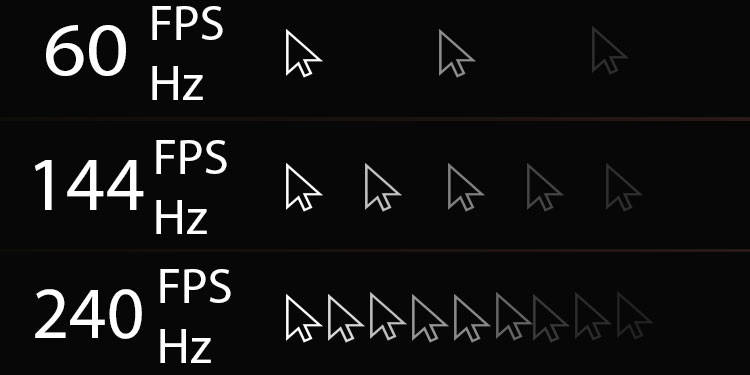Understanding the Relationship Between Refresh Rates (Hz) and Frame Rates (FPS)
What Are Refresh Rates (Hz)
Refresh rates, measured in Hertz (Hz), refer to the rate at which a display screen refreshes itself to display new images. Most commonly, refresh rates determine how many times per second the display can redraw the screen from top to bottom. For standard computer monitors, the typical refresh rate is 60Hz, which means the screen refreshes itself 60 times every second. This allows for buttery smooth visuals when viewing movies, photos, browsing the web, or doing basic productivity tasks. However, for more demanding applications like gaming that requires responsive inputs and smooth animations, a higher refresh rate can make a big difference in the user experience.
The Basics of Monitor Refresh Rates
Monitor refresh rates have historically remained at either 60Hz or 75Hz for many years because those rates were sufficient for most general computing needs. However, as gaming and multimedia usage increased demand for smoother visuals, manufacturers started introducing displays with higher refresh capabilities. Today, most high-end gaming monitors support 144Hz or even 240Hz ultra-high refresh rates for an ultra-responsive gaming experience. Refresh rates do have drawbacks too. Higher refresh rates require more processing power from the graphics card and increased power consumption from the monitor. They also tend to increase costs. So for average users, a standard 60Hz rate is still perfectly adequate for all common tasks.
What Are Frame Rates (FPS)
In contrast to refresh rates measured in Hz, frame rates refer to the rate at which discrete images or “frames” in a video can be completely rendered in each second of playback. Commonly abbreviated as FPS (frames per second), frame rates determine how smoothly animated content like movies and games will appear to the eye.
The Role of FPS in Gaming
For gaming applications, higher FPS results in a much smoother visual experience with less stuttering and tearing. More frames processed per second means individual animations and actions are broken down into smaller increments, appearing far more fluid to the player. This is extremely important for fast-paced, twitch-reaction based games where split-second responsiveness matters. Most games target a frame rate that matches the monitor’s refresh rate to avoid potential screen tearing issues. For example, targeting 60FPS on a 60Hz monitor ensures each frame lines up perfectly with a refresh cycle. However, maintaining frame rates well above the refresh rate, like 120FPS or 144FPS on a 60Hz screen, still provides some benefits in smoothness even if tearing occurs.
The Relationship Between Refresh Rates and Frame Rates
The key relationship between refresh rates and frame rates is that the monitor’s refresh rate determines the highest sustainable frame rate that can be displayed before visual artifacts start appearing. This is because the refresh rate dictates how frequently the monitor can redraw itself top to bottom to synchronize with incoming frames from the graphics card.
Refreshes Must Match Frame Delivery
If the frame rate delivered by the graphics card exceeds the monitor’s refresh rate capacity, screen tearing can result. This happens when the monitor tries to refresh in the middle of a frame, splitting it across refreshes and causing unsightly visual inconsistencies. To eliminate tearing, frame rates need to tie into whole number multiples of the refresh rate for consistent synchronization. For example, on a 60Hz display, frame rates of 60FPS, 120FPS, 180FPS etc. would line up perfectly without tearing. But 75FPS would cause issues as it’s an inconsistent fraction of the refresh cycles. Advanced Sync technologies like Nvidia G-Sync and AMD FreeSync allow dynamic refresh rates to precisely match fluctuating frame rates in real-time for tear-free gaming.
The Effect of Refresh Rates on Maximum FPS
In practical terms, having a faster refresh rate monitor allows for a higher sustainable upper limit on playable frame rates before negative visual effects start occurring. A 240Hz display supports frame rates comfortably into the 200FPS+ range without issues, while 60Hz inherently caps the smooth performance window significantly lower at just 60FPS. For consistent, high refresh rate gaming, it’s important to have not only a powerful enough GPU, but also a high-end monitor that can keep up with the fast frame times it can produce. High refresh remains essential for competitive esports titles where visual response is crucial.
Balancing Frame Rates and Refresh Rates
With a strong understanding of the relationship between these interface factors, PC users can optimize settings to maximize performance and smoothness for varied applications and hardware capabilities. For most daily productivity and casual gaming, standard 60Hz monitors paired with modest mid-range GPUs targeting 60FPS are perfectly adequate. However, those who play highly reflex-based games at a competitive level tend to favor higher refresh displays and aim for frame rates uncapped well beyond what’s necessary just for smooth visuals. Advanced technologies like FreeSync and G-Sync also allow balancing frame rates dynamically based on rendering loads rather than trying to maintain perfect synchronization at all times. This alleviates unnecessary performance impacts while still eliminating tearing virtually unnoticeably. With careful tuning informed by refresh rate specifications and application needs, system builders can develop configurations tuned for specific gameplay experiences. While chasing the absolute highest specs isn’t always necessary, understanding these fundamental concept ties it all together cohesively.
Conclusion
In summary, the relationship between refresh rates and frame rates forms the core foundation for optimizing motion response across gaming and multimedia interfaces. Monitor refresh rates dictate sustainable maximum frame rates, while pushing beyond also provides benefits. With advanced syncing tech, these metrics can dynamically balance for optimal experiences across all levels of hardware. Gaining a robust conceptual grasp of Hz versus FPS principles continues enhancing digital pleasures smoothly into the future.
